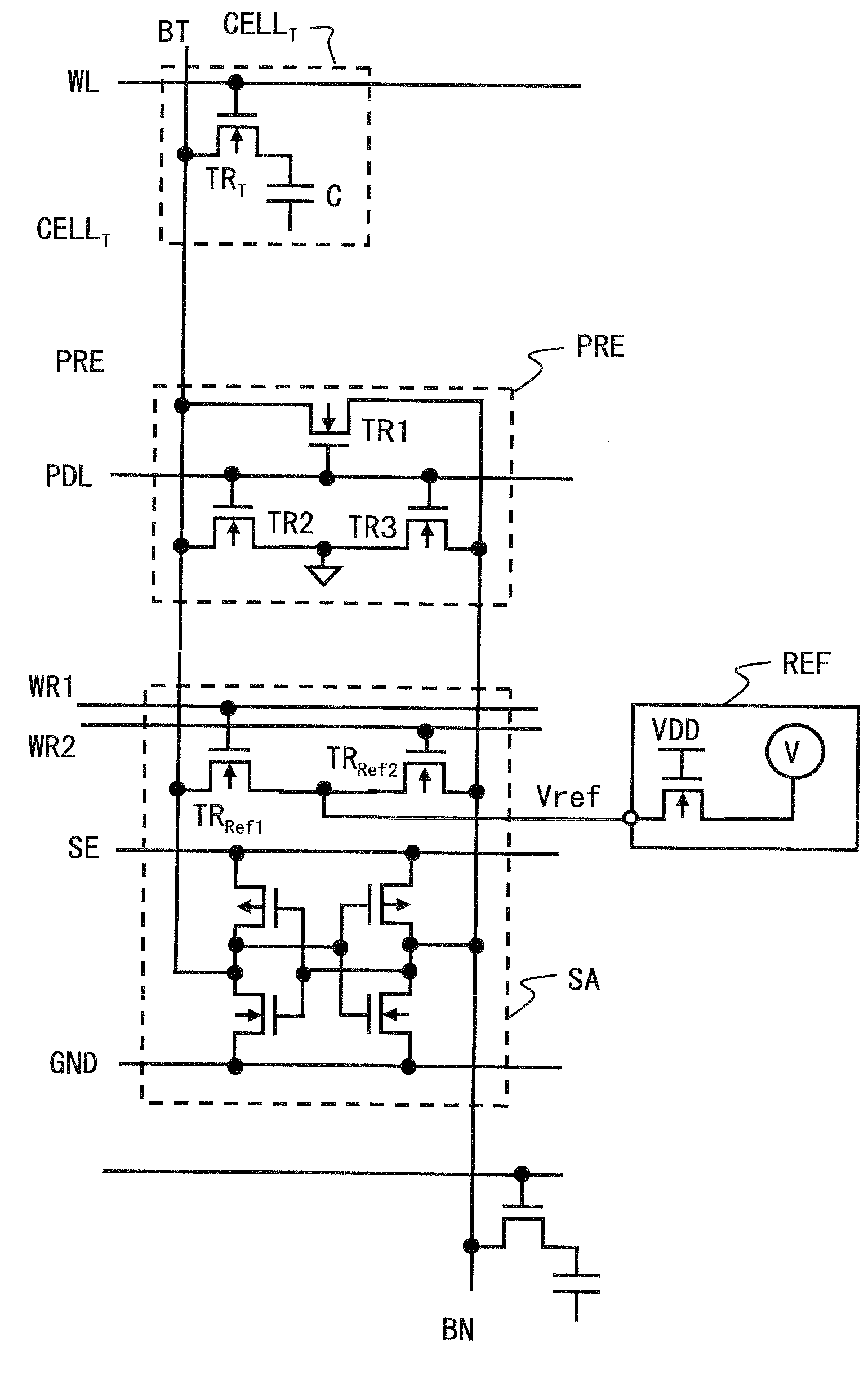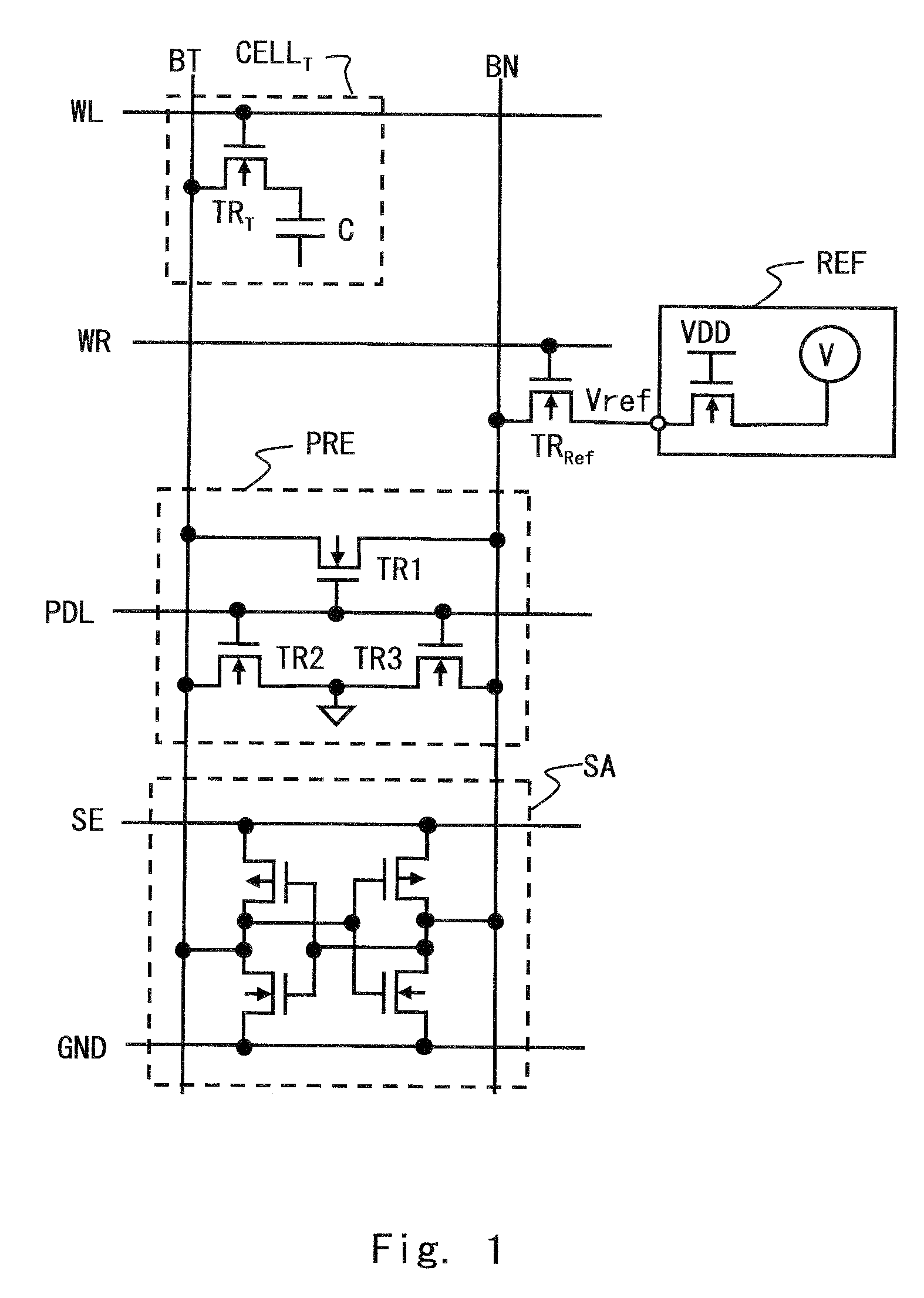Semiconductor memory device
a memory device and semiconductor technology, applied in the field of semiconductor memory devices, can solve the problems of increasing the voltage output of the ref-cell cell/sub>ref /sub>, the voltage output of the ref-cell cell/sub>is not enough for the sense amplifier to operate with high stability, and the difficulty of amplifying the difference of potential between bit lines potential with high accuracy, etc., to achieve the effect of suppressing the increase of current consumption and high stability
- Summary
- Abstract
- Description
- Claims
- Application Information
AI Technical Summary
Benefits of technology
Problems solved by technology
Method used
Image
Examples
first embodiment
[0027]A first embodiment of this invention is explained below with references to drawings. FIG. 1 is a view showing a circuit of one of a bit line pair of a DRAM of this embodiment. As shown in FIG. 1, the DRAM of this embodiment includes bit lines BT, BN, a memory cell CELLT, a transistor for supplying a reference voltage (a reference voltage supply switch) TRRef, a precharge circuit PRE, a sense amplifier SA, and a reference voltage generation circuit REF. Note that the memory cell CELLT memorizes data and hereinafter referred to as a main cell.
[0028]The main cell CELLT is comprised of an n-mos (n-type Metal Oxide Semiconductor) transistor TRT and a capacitor C. A gate of the transistor TRT of the main cell CELLT is connected to a word line WL. One of a source or drain of the main cell CELLT is connected to a bit line BT and the other is connected to the capacitor C. The main cell CELLT memorizes a logical value of H or L by storing charge in the capacitor C. When the charges stor...
second embodiment
[0051]A second embodiment of this invention is explained below with references to drawings. A plurality of memory cells are connected to one sense amplifier in an actual DRAM. FIGS. 4A and 4B each shows an exemplary layout of connecting the plurality of memory cells to one sense amplifier. Note that the precharge circuit and other elements are omitted in FIGS. 4A and 4B, because FIGS. 4A and 4B are views for explaining exemplary layouts.
[0052]FIG. 4A shows a layout of a folded bit arrangement where a bit line pair is arranged at one side of the sense amplifier. As shown in FIG. 4A, the sense amplifier SA is shared among the bit line pair BT1 and BN1 at the right side and the bit line pair BT2 and BN2 at the left side. Note that, the words indicating the directions are used on the assumption that the drawings are seen in front.
[0053]FIG. 4B shows a layout of an open bit arrangement where a bit line pair is formed by arranging a bit line BT at the left side of the sense amplifier and ...
third embodiment
[0069]FIG. 7 is a circuit diagram showing a bit line pair of a memory cell of the third embodiment of this invention. The same components as those of FIGS. 1 and 5 are denoted by identical reference numerals and undue explanation is omitted. The memory of this embodiment adopts the folded bit arrangement as shown in FIG. 4A.
[0070]The difference between the circuit of FIG. 5 and the circuit of FIG. 7 is that it is possible to input signals to each of the bit line pair selection transistors TR4 to TR7 for independently controlling the conductive states of each transistors TR4 to TR7.
[0071]As a result of adopting this configuration, only the TG1 is set to H level and only the transistor TR4 is set to be conductive in accessing the main cell CELLT that is connected to the bit line BT as shown in FIG. 7 for example. Other control signals TG2 to TG4 are set to L level and non-conductive states are sustained.
[0072]In the condition explained above, not all the bit line pairs BN1 are set to ...
PUM
 Login to View More
Login to View More Abstract
Description
Claims
Application Information
 Login to View More
Login to View More - R&D
- Intellectual Property
- Life Sciences
- Materials
- Tech Scout
- Unparalleled Data Quality
- Higher Quality Content
- 60% Fewer Hallucinations
Browse by: Latest US Patents, China's latest patents, Technical Efficacy Thesaurus, Application Domain, Technology Topic, Popular Technical Reports.
© 2025 PatSnap. All rights reserved.Legal|Privacy policy|Modern Slavery Act Transparency Statement|Sitemap|About US| Contact US: help@patsnap.com



